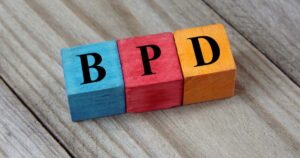Living with borderline personality disorder (BPD) presents unique challenges, and when coupled with substance abuse, these challenges can become even more complex. This blog explores the intersection of borderline personality disorder and substance abuse, shedding light on the connections, challenges, and potential pathways to healing for individuals facing these intertwined struggles.
Contents
What Is The Link Between BPD And Substance Abuse?
 The link between borderline personality disorder and substance abuse is multifaceted and complex, involving both biological and psychological factors. Here are some key aspects of this connection:
The link between borderline personality disorder and substance abuse is multifaceted and complex, involving both biological and psychological factors. Here are some key aspects of this connection:
- Self-Medication
Individuals with BPD often experience intense emotional distress, mood swings, and difficulty regulating their emotions. They may turn to substances such as alcohol or drugs as a way to cope with these overwhelming feelings and to temporarily alleviate emotional pain.
- Impulsivity
Impulsivity is a hallmark feature of BPD, characterized by acting without considering the consequences. This impulsivity can lead individuals to engage in risky behaviors, including substance abuse, without fully considering the long-term effects.
- Sensitivity to Rejection and Abandonment
People with BPD often have a heightened sensitivity to perceived rejection or abandonment. This can lead to intense feelings of loneliness and emptiness. Substance abuse may be used as a way to numb these painful emotions or to escape from feelings of isolation.
- Biological Factors
There may be shared genetic or neurobiological vulnerabilities between BPD and substance abuse disorders. Some research suggests that certain neurotransmitter systems, such as those involving serotonin and dopamine, may be dysregulated in both BPD and addiction.
- Trauma and Co-Occurring Disorders
Many individuals with BPD have a history of trauma, such as childhood abuse or neglect. Trauma is a significant risk factor for both BPD and substance abuse. Individuals with BPD may use substances as a way to cope with unresolved trauma or PTSD symptoms.
Overall, the link between BPD and substance abuse is complex and bidirectional, with each condition influencing and exacerbating the other. Effective treatment often requires addressing both BPD symptoms and substance use behaviors concurrently through integrated approaches.
What Type Of Abuse Causes Borderline Personality Disorder?
Borderline personality disorder (BPD) does not have a single cause. But rather, it is believed to result from genetic, biological, environmental, and psychological factors. Abuse, particularly during childhood, is one of the environmental factors that has been linked to the development of BPD in some individuals.
Types of abuse that may contribute to the development of BPD include:
- Physical Abuse: This involves the intentional infliction of physical harm or injury, such as hitting, punching, or kicking. Physical abuse can be particularly damaging when experienced during childhood, as it can lead to feelings of fear, helplessness, and a lack of safety.
- Emotional Abuse: Emotional abuse encompasses a range of behaviors aimed at undermining an individual’s self-esteem, self-worth, and emotional well-being. This can include verbal insults, constant criticism, humiliation, rejection, and threats.
- Sexual Abuse: Sexual abuse involves any form of unwanted sexual activity or exploitation, including molestation, rape, incest, or sexual harassment. Sexual abuse can lead to profound feelings of shame, guilt, and confusion, as well as difficulties with intimacy and trust.
- Neglect: Neglect refers to the failure of caregivers to provide for a child’s basic physical, emotional, or psychological needs. This can include neglecting to provide adequate food, shelter, clothing, medical care, or emotional support.
- Trauma: Traumatic experiences, such as witnessing violence, experiencing natural disasters, or being involved in accidents, can also contribute to the development of BPD. Trauma can disrupt a person’s sense of safety and security.
It’s important to note that not everyone who experiences abuse or trauma will develop BPD. Not everyone with BPD has a history of abuse.
Symptoms Of Borderline Personality Disorder And Substance Abuse
 When borderline personality disorder (BPD) co-occurs with substance abuse, the symptoms can intersect and exacerbate each other, leading to significant challenges in diagnosis, treatment, and recovery.
When borderline personality disorder (BPD) co-occurs with substance abuse, the symptoms can intersect and exacerbate each other, leading to significant challenges in diagnosis, treatment, and recovery.
Common symptoms
Here are some common symptoms that may manifest when borderline personality disorder and substance abuse occur together:
Impulsivity
Both BPD and substance abuse are characterized by impulsivity, such as engaging in risky behaviors without considering the consequences. This can include reckless driving, unsafe sexual practices, or impulsive substance use.
Emotional Dysregulation
Individuals with BPD often struggle with intense and rapidly shifting emotions, such as anger, anxiety, and sadness. Substance abuse can further destabilize emotions. Thus, leading to mood swings, irritability, and emotional outbursts.
Self-Destructive Behaviors
People with BPD may engage in self-destructive behaviors, such as self-harm, suicidal ideation, or reckless substance use. Substance abuse can exacerbate these tendencies, increasing the risk of harm to oneself.
Identity Disturbance
BPD often involves a pervasive sense of instability in self-image, identity, and goals. Substance abuse can further disrupt one’s sense of identity, leading to confusion, feelings of emptiness, and difficulty establishing a coherent sense of self.
Interpersonal Problems
Individuals with BPD often struggle with turbulent relationships characterized by fear of abandonment, intense idealization and devaluation of others, and conflicts. Substance abuse can impair judgment and communication, leading to further interpersonal difficulties and conflicts with loved ones.
Distorted Thinking
Both BPD and substance abuse can be associated with distorted thinking patterns, such as black-and-white thinking, paranoia, or cognitive rigidity. These cognitive distortions can contribute to difficulties coping with stress and managing emotions.
Avoidance of Emotional Pain
Both BPD and substance abuse may involve attempts to avoid or numb emotional pain. Individuals may use substances as a way to escape from distressing emotions or traumatic memories associated with BPD symptoms.
Cyclical Patterns
BPD and substance abuse often exhibit cyclical patterns, with substance use exacerbating BPD symptoms and vice versa. This can create a self-perpetuating cycle of distress and dysfunction that is difficult to break without targeted intervention.
It’s important to recognize that these symptoms can vary in severity and presentation among individuals, and not everyone with BPD will experience substance abuse, and vice versa. However, when these conditions co-occur, integrated treatment approaches are essential for promoting recovery and improving overall well-being.
How To Manage Both BPD And Substance Abuse?
 Managing both borderline personality disorder and substance abuse requires a comprehensive and integrated approach that addresses the unique challenges and complexities of each condition. Here are some strategies for managing both BPD and substance abuse:
Managing both borderline personality disorder and substance abuse requires a comprehensive and integrated approach that addresses the unique challenges and complexities of each condition. Here are some strategies for managing both BPD and substance abuse:
1. Seek Professional Help
Consult with mental health professionals who specialize in treating co-occurring disorders. Therapists, psychiatrists, and addiction specialists can work together to develop a personalized treatment plan that addresses both BPD and substance abuse.
2. Integrated Treatment
Consider treatment programs that offer integrated or dual diagnosis treatment for co-occurring disorders. These programs provide simultaneous treatment for BPD and substance abuse, addressing both conditions concurrently.
3. Medication Management
Work with a psychiatrist to explore medication options for managing symptoms of BPD, such as mood stabilizers or antidepressants. Medication may also help address co-occurring mental health conditions or manage withdrawal symptoms during substance abuse treatment.
4. Therapy
Engage in therapy, particularly evidence-based approaches such as dialectical behavior therapy (DBT), which is specifically designed to treat BPD. DBT teaches coping skills for emotion regulation, distress tolerance, interpersonal effectiveness, and mindfulness. This can be valuable for managing both BPD symptoms and substance cravings.
5. Substance Abuse Treatment
Participate in substance abuse treatment programs that offer a combination of individual counseling, group therapy, and support groups. These programs can help individuals address the underlying issues driving substance abuse, develop relapse prevention strategies, and build a supportive recovery network.
6. Develop Healthy Coping Mechanisms
Identify healthy coping mechanisms and alternative activities to replace substance use. This may include exercise, hobbies, mindfulness practices, creative outlets, or spending time with supportive friends and family members.
7. Address Trauma
If trauma is a contributing factor to both BPD and substance abuse, consider trauma-focused therapy to process and heal from past traumatic experiences. Trauma-informed approaches can help individuals develop healthier coping strategies and reduce the risk of using substances to cope with trauma-related symptoms.
8. Build a Support Network
Surround yourself with supportive individuals who understand both BPD and substance abuse and can provide encouragement, empathy, and accountability throughout the recovery process. Peer support groups, such as Alcoholics Anonymous (AA) or Narcotics Anonymous (NA), can also be valuable sources of support.
9. Practice Self-Care
Prioritize self-care activities that promote overall well-being, such as getting adequate sleep, eating a balanced diet, exercising regularly, and engaging in activities that bring joy and fulfillment.
10. Monitor Progress
Regularly assess progress in managing both BPD and substance abuse and adjust treatment strategies as needed. Set realistic goals and celebrate milestones in recovery, no matter how small.
Managing both BPD and substance abuse requires commitment, patience, and ongoing support, but with the right resources and strategies, recovery is possible. Remember that progress may be gradual, and setbacks are a natural part of recovery.
Conclusion
In conclusion, managing borderline personality disorder and substance abuse requires a holistic approach that addresses the unique challenges of both conditions. By seeking professional help, engaging in integrated treatment programs, and developing healthy coping mechanisms, individuals can work towards healing and recovery.
Therapy, medication management, and support from peers and loved ones play crucial roles in this journey. It’s important to remember that progress takes time, and setbacks are normal. With commitment, patience, and perseverance, individuals can navigate the complexities of BPD and substance abuse, ultimately leading to a healthier and more fulfilling life.
